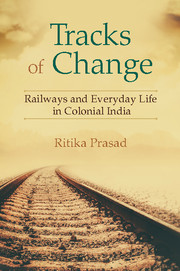Book contents
- Frontmatter
- Dedication
- Contents
- List of Tables and Figures
- Acknowledgements
- List of Abbreviations
- Introduction
- 1 The Nature of the Beast? An Elementary Logic for Third-Class Travel
- 2 Demand and Supply? Railway Space and Social Taxonomy
- 3 Crime and Punishment: In the Shadow of Railway Embankments
- 4 Railway Time: Speed, Synchronization, and ‘Time-Sense’
- 5 Contagion and Control: Managing Disease, Epidemics, and Mobility
- 6 Designing Rule: Power, Efficiency, and Anxiety
- 7 Marking Citizen from Denizen: Dissent, ‘Rogues,’ and Rupture
- Conclusion
- Bibliography
- Index
- About the Author
Conclusion
Published online by Cambridge University Press: 05 September 2015
- Frontmatter
- Dedication
- Contents
- List of Tables and Figures
- Acknowledgements
- List of Abbreviations
- Introduction
- 1 The Nature of the Beast? An Elementary Logic for Third-Class Travel
- 2 Demand and Supply? Railway Space and Social Taxonomy
- 3 Crime and Punishment: In the Shadow of Railway Embankments
- 4 Railway Time: Speed, Synchronization, and ‘Time-Sense’
- 5 Contagion and Control: Managing Disease, Epidemics, and Mobility
- 6 Designing Rule: Power, Efficiency, and Anxiety
- 7 Marking Citizen from Denizen: Dissent, ‘Rogues,’ and Rupture
- Conclusion
- Bibliography
- Index
- About the Author
Summary
Transport technology has changed significantly since passenger railways first began running in the mid-nineteenth century. Domestic and international airline travel is a booming industry, automobiles and buses increasingly choke urban traffic, and metro rail systems are proliferating as a mass transit necessity in many cities. However, railway transport remains central to India's public. In 2012–13, railways in India carried an astounding eight billion passengers. The significance of this figure is even more dramatic when contrasted with the number of people using other forms of transport: in 2012-13, the number of airline passengers, both domestic and international, was somewhere between 60 and 75 million, while the total number of registered motor vehicles in 2012—including taxis, two-wheelers, buses, and goods vehicles—stood at 159.49 million. It is not only numbers, however, that speak to the continuing relevance of railways in India. This book has suggested some of the important ways in which, from the mid- to late nineteenth century onwards, Indians felt the ever-increasing presence of railways in their lives, being compelled to negotiate the wide range of transformations being wrought by railway travel, technology, and infrastructure. Many of these remain true even today. To highlight both the enduring impact of railway technology in the lives of Indians as well as how the historical meaning of new technology is materialized through everyday use, this conclusion will briefly juxtapose two transport ‘revolutions’ separated by more than a century.
If the mid- to late nineteenth century was characterized by the railway ‘revolution,’ then in the last decade or so a more recent ‘transportation revolution’ has occupied a fair share of public conversation in India. The Delhi metro, a rapid mass transit system, has garnered national and international attention for its technological sophistication: including the engineering gymnastics required to build ‘in, above and beneath some of the most densely populated square miles on earth,’ the regenerative braking system that allowed it to save 1,12,500 megawatt hours of power generation between 2004 and 2007, and its being built to resist earthquakes up to 7.5 on the Richter scale.
- Type
- Chapter
- Information
- Tracks of ChangeRailways and Everyday Life in Colonial India, pp. 263 - 282Publisher: Cambridge University PressPrint publication year: 2015

